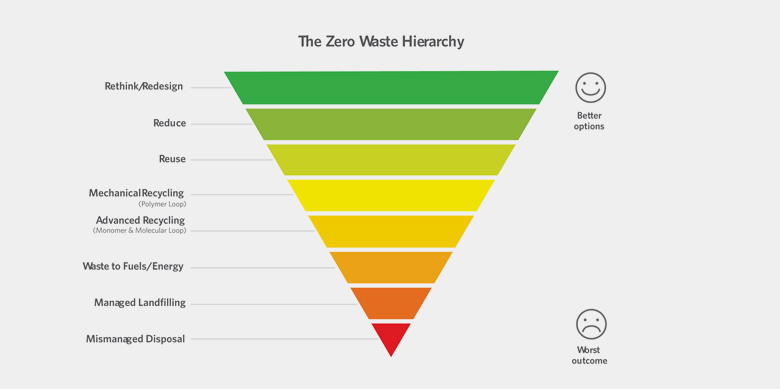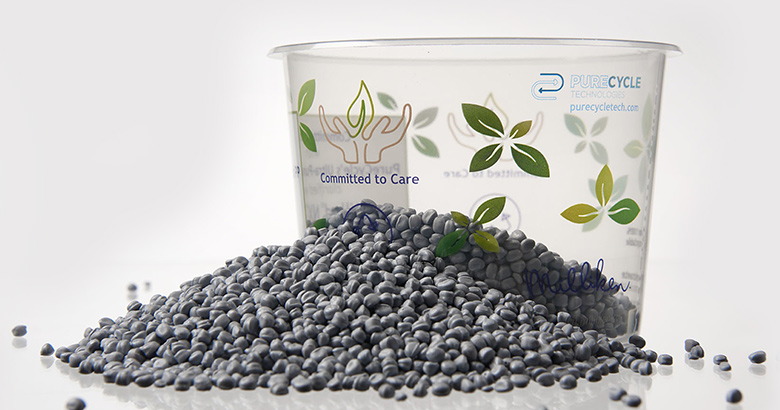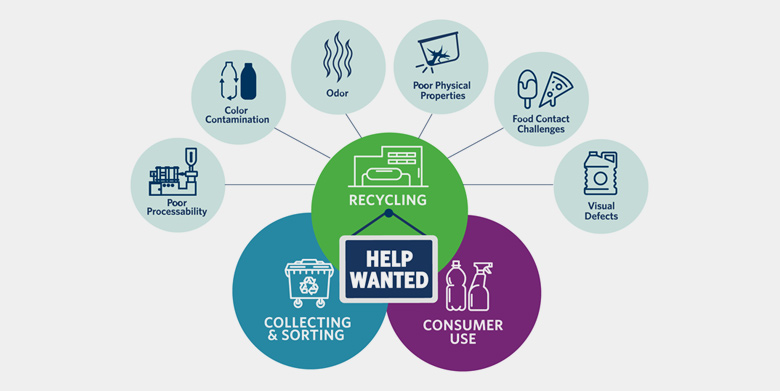Polymer science driving the transition to a circular economy for plastics
October 14, 2020 by Scott R. Trenor, Ph.D.The volumes are huge. In 2018, the global production of plastics was estimated to be 360 million tons with approximately half of that, 170 million tons, used for packaging applications. That same year we generated 250 million tons of plastic waste with a bit over a third of that mismanaged, or leaked, into the environment.1 It’s not surprising, then, that plastic packaging has gained an increasing amount of attention in all aspects of society.
The staggering amounts of plastic produced speak to its excellent properties, performance and economics and underline why, over the past several decades, plastic has become the material of choice. Plastic packaging plays an important role in the safe shelf life extension of fresh fruits and vegetables such as broccoli,2 mangos,3 bananas4 and many others.5 Fresh proteins such as poultry,6 beef and fish7 also benefit greatly.
In addition, plastic packaging has environmental benefits in comparison to other materials. It gained its market presence by replacing, for example, glass for carbonated beverages. Plastics could be replaced; however, these replacement materials could come with a significant life-cycle burden, especially when considering climate change. The Plastics Division of the American Chemistry Council recently published a study on the potential effects of substitution.8 Converting from plastic packaging to alternatives generated 69% more CO2 emissions and 390% more solid waste by weight (83% by volume) and consumed 90% more energy and 481% more water.
What is commonly understood is that the end of life of plastics is not well managed. This has led to plastic waste in our land environment and in our oceans, driving legislative, industrial and voluntary actions to force changes. While the plastics recycling industry has made many advances in its relatively short life, there are still many technical and societal hurdles that need to be overcome.
Recycling’s role in a circular economy for plastics
At Milliken we believe that it is possible to overcome these hurdles, with each stage along the path from packaging design, material selection, construction, sortation, recycling and reprocessing ripe for innovation. The Ellen MacArthur Foundation (EMF), in its 2016 report on the New Plastics Economy9, outlined the imperative for a plastics circular economy, projected to be worth $4.5 trillion by 203010.
In 2018, the EMF launched the New Plastics Economy Global Commitment in collaboration with the UN Environment Programme. Today, more than 450 consumer packaged goods companies, raw material producers, recyclers, governments, and others have made the commitment to “eliminate the plastic items we don’t need; innovate so all plastics we do need are designed to be safely reused, recycled or composted; and circulate everything we use to keep it in the economy and out of the environment”11. The mandate to redesign the entire value chain of plastics has already made its way into industry initiatives and active legislation12, 13, 14, 15, leading to the incorporation and elevation of sustainability goals in almost every company, including Milliken’s goals for plastic packaging and a more evolved waste hierarchy, see figure 1.

Figure 1. Milliken’s Zero Waste Hierarchy. Adapted in part from the European Commission’s Waste Framework Directive16, 17.
Milliken’s contributions to the circularity challenge
At Milliken we hope that we move to a world where all materials are recycled, regardless of material type and application. However, the actual recyclability of a package is more complex than just polymer type and is dependent on many factors including the material of construction, access to a collection system that accepts the article, size of the article, shape of the article and ability to sort the article correctly and process it into a feedstock suitable for new products. There are many important, large scale initiatives to address these challenges, including: the introduction of Artificial Intelligence and digital water-marking in recycling sortation; depolymerization; conversion, in which plastics are converted to petrochemicals and refined hydrocarbons using pyrolysis and/or gasification of the plastic waste; and projects to harmonize packaging design globally.
To advance mechanical recycling towards a circular economy, the difficulties of turning recycled materials into new products also need to be addressed. Milliken has partnered with PureCycle Technologies to restore used polypropylene (PP) plastic to 'virgin-like' quality with a revolutionary recycling method and Milliken’s additives, such as Millad® NX® 8000 ECO, will play a critical role by restoring key properties of the PP.
In the United States, PureCycle has constructed a pilot plant in Ohio for purifying PP that processes approximately 10 kg/hour. The company uses a supercritical extraction process to remove contaminants from either PP18 or PE.19 Figure 2 shows the effectiveness of this purification process, where PureCycle has processed recycled carpet fiber to produce a rPP for a TWIM (thin-wall injection molded) food container. The company is beginning construction on its first full-scale recycling plant with the capacity to treat approximately 50 kt/year of recycled PP.20

Figure 2. Portion cup injection molded from post-consumer recycled PP processed by PureCycle Technologies.
While recycling via purification can separate different polymers and remove colors, odors and other contaminants, the processes have limitations similar to those of other mechanical recycling methods. Improvements in impact strength, modulus and viscosity all may be necessary, and require tradeoffs, when used individually or in combination.

Pushing science for plastics circularity
The polymer science community has devoted the last 100 years to finding elegant and scalable methods to build up molecular weight to produce functional plastics. Now, we need to shift towards a circular mindset of mending polymers for improved mechanical recycling.
The technical approaches, skillsets and solutions needed to tackle these issues vary greatly and span the entire recycling system. They begin with processes and analytical systems to improve material detection and decrease contamination during sortation. Once sorted, materials must undergo processes, chemistries and modifications to decontaminate and restore the mechanical and aesthetic properties of recycled plastics. For materials that cannot be mechanically recycled, efficient processes and catalysts will need to be developed that lower the energy requirement for the synthesis of “new” plastics from recycled feedstocks. Collaborations of this type, such as the one between Milliken and PureCycle, are the hallmark of the polymer science community and offer us an opportunity for tremendous positive impact for generations to come.
Read more: https://pubs.acs.org/doi/10.1021/acsmacrolett.0c00437
THIS IS AN UNOFFICIAL ADAPTATION OF AN ARTICLE THAT APPEARED IN AN ACS PUBLICATION. ACS HAS NOT ENDORSED THE CONTENT OF THIS ADAPTATION OR THE CONTEXT OF ITS USE.
References
1 Conversio Market & Strategy GmbH Global Plastics Flow 2018. http://www.conversio-gmbh.com/res/Global_Plastics_Flow_Feb10_2020.pdf; Accessed April 10, 2020.
2 Lucera, A.; Costa, C.; Mastromatteo, Marcella; Conte, A.; Nobile, M.; Fresh-cut broccoli florets shelf-life as affected by packaging film mass transport properties. Journal of food engineering 2011, 122-129.
3 Boonruang, K.; Chonhenchob, V.; Singh, S. P.; Chinsirikul, W.; Fuongfuchat, A.; Comparison of various packaging films for mango export. Packaging Technology and Science 2012, 107-118.
4 Hailu, M., T.; Workneh, S.; Belew D.; Effect of packaging materials on shelf life and quality of banana cultivars (Musa spp.). Journal of Food Science and Technology 2012, 1-17.
5 Oliveira, M.; Abadias, M.; Usall, J.; Torres, R.; Teixido, N.; Vinas, I.; Application of modified atmosphere packaging as a safety approach to fresh-cut fruits and vegetables - A review. Trends in Food Science & Technology 2015, 46(1), 13-26.
6 Sawaya, W. N.; Elnawawy, A.S.; Abu-Ruwaida, A.S.; Khalafawi, S.; Dashti, B.; Influence of modified atmosphere packag-ing on shelf-life of chicken carcasses under refrigerated storage conditions. Journal of Food Safety 1995, 35-51.
7 DeWitt, C.A.M.; Oliveira, A.C.M.; Modified Atmosphere Systems and Shelf Life Extension of Fish and Fishery Products. Foods 2016, 5(3), 48.
8 Franklin Associates, A Division of Eastern Research Group (ERG); Life cycle impacts of plastic packaging compared to substitutes in the United States and Canada: Theoretical Substitution Analysis. 2018 https://plastics.americanchemistry.com/Reports-and-Publications/LCA-of-Plastic-Packaging-Compared-to-Substitutes.pdf; Accessed May 12, 2020.
9 World Economic Forum, Ellen MacArthur Foundation and McKinsey & Company; The New Plastics Economy - Rethink-ing the future of plastics 2016, http://www.ellenmacarthurfoundation.org/publications; Accessed May 12, 2020.
10 Closed Loop Partners; A Linear Take-Make-Waste Economy Has Prevailed For The Last 50 Years, But The Circular Economy Is Where Value Will Be Created In The 21st Century; https://www.closedlooppartners.com/a-linear-take-make-waste-economy-has-prevailed-for-the-last-50-years-but-the-circular-economy-is-where-value-will-be-created-in-the-21st-century/; Accessed May 12, 2020.
11 World Economic Forum, Ellen MacArthur Foundation; The New Plastics Economy Global Commitment 2019 Progress Report. https://www.newplasticseconomy.org/about/publications/global-commitment-2019-progress-report; Accessed May 12, 2020.
12 European Commission; A European Strategy for Plastics in a Circular Economy January 16, 2018; https://ec.europa.eu/environment/circular-economy/pdf/plastics-strategy-brochure.pdf; Accessed April, 20, 2020.
13 European Commission; Circular Economy Action Plan: For a cleaner and more competitive Europe. https://ec.europa.eu/environment/circular-economy/pdf/new_circular_economy_action_plan.pdf; Accessed April, 20, 2020.
14 van Bruggen, A. R.; Dekker, E.; Waaijers-van der Loop, S.L.; Plastic Pact Nederland de Monitor Nulmeting (2017-2018); https://www.rivm.nl/publicaties/plastic-pact-nederland-monitor-nulmeting-2017-2018; Accessed April 20, 2020.
15 République Française; Pacte National sur les emballages plastiques 21 février 2019; https://www.ecologique-solidaire.gouv.fr/sites/default/files/2019.02.21_Pacte_ National_emballages_plastiques.pdf; Accessed May 12, 2020.
16 European Commission; "Directive 2008/98/EC on waste (Waste Framework Directive)" March 12, 2014; https://ec.europa.eu/environment/waste/framework; Accessed April 20, 2020.
17 Simon, J. M.; A Zero Waste hierarchy for Europe: New tools for new times. From waste management to resource man-agement. May 20, 2019; https://zerowasteeurope.eu/2019/05/a-zero-waste-hierarchy-for-europe; Accessed April 20, 2020.
18 Layman, J. M.; Gunnerson, M.; Schonemann, H.; Williams, K.; Method for purifying contaminated polypropylene. US9834621; December 5, 2017.
19 Layman, J. M.; Gunnerson, M.; Schonemann, H.; Williams, K.; Method for purifying contaminated polyethylene. US9803035; October 31, 2017.
20 https://www.globenewswire.com/news-release/2019/03/13/ 1752436/0/en/PureCycle-Technologies-Partners-with-Milliken-Nestl%C3%A9-to-Accelerate-Revolutionary-Plastics-Recycling.html; April 13, 2020.
